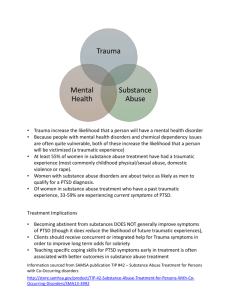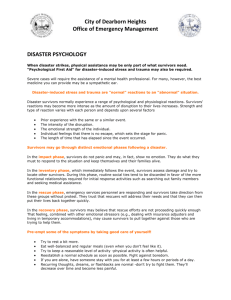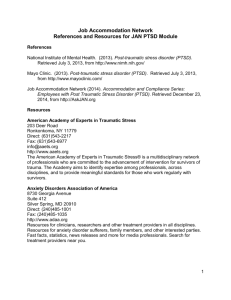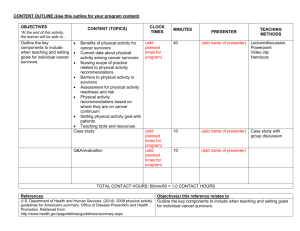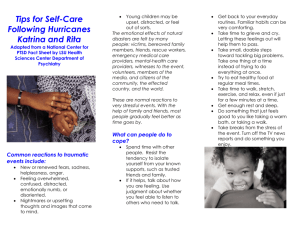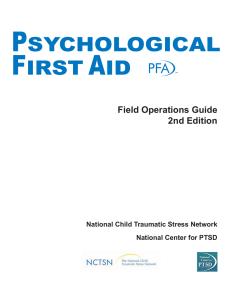CERT Unit 7 - Lamorinda CERT
advertisement
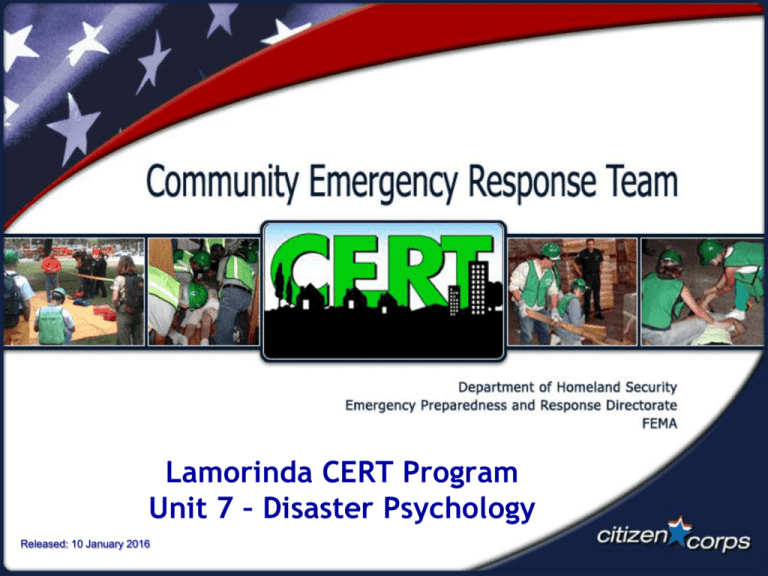
Lamorinda CERT Program Unit 7 – Disaster Psychology Released: 10 January 2016 Community Emergency Response Team Personal safety is ALWAYS the number one priority Work as a team Wear personal protective equipment…gloves, helmet, goggles, N95 mask and boots The CERT goal is to do the Greatest Good for the Greatest Number Hope for the best but plan for the worst Visual 7.1 Unit Objectives Describe the disaster and post-disaster emotional environment for victims and rescuers Describe the steps that rescuers can take to relieve their own stress and that of disaster survivors Visual 7.2 Vicarious Trauma The process of changes in the rescuer resulting from empathic engagement with survivors Visual 7.3 Disturbing legacy of rescues: Suicide Bob Long, a surveyor credited with finding the nine trapped coal miners in Pennsylvania, killed himself the following June. Terry Yeakey, an Oklahoma City police sergeant who rescued four bombing victims in 1995, committed suicide the following year. Robert O'Donnell, a paramedic who played a crucial role in saving baby Jessica McClure from a Texas well shaft in 1987, took his life nearly eight years later. Visual 7.4 September 11th Aftermath Long after 9/11, survivors were still emerging: Nine months later, Fire Department of New York paramedic Daniel Stewart, 27, hanged himself in the basement of his Long Island home. In his suicide note, Stewart wrote of the horrors of excavating bodies from the wreckage of the World Trade Center. James Kay Jr., an emergency medical technician, shot himself in early 2002. Gary Celentani, 33, a strapping firefighter who followed two brothers into the New York City Fire Department, was at home Sept. 25, 2002, when he shot himself to death with a rifle. Visual 7.5 Oklahoma City Bombing Since the bombing, Oklahoma City police have counted at least six suicides of people directly involved in the disaster -including a bombing survivor, two police officers and a Denver federal prosecutor who participated in the Timothy McVeigh investigation. Visual 7.6 Rescuer Psychological Trauma Your own personal losses Working in your neighborhood Assisting neighbors, friends, co-workers who have also been injured Not feeling safe and secure Visual 7.7 Possible Psychological Symptoms Irritability, anger Self-blame, blaming others Isolation, withdrawal Fear of recurrence Feeling stunned, numb, or overwhelmed Feeling helpless Mood swings Sadness, depression, grief Denial Concentration, memory problems Relationship conflicts / marital discord Suicidal ideation Visual 7.8 Risk / Resiliency Markers Younger people at greater risk than older people Women greater risk than men Volunteers have higher risk Veterans of recent wars—OIF/OND/OEF more susceptible than Vietnam and Korea Those with previous psychological difficulties are more at risk Lower social support increases risk OIF-Operation Iraqi Freedom 3/03-9/11; OND-Operation New Dawn troop withdrawal 9/11-12/11; OEF-Operation Enduring Freedom official name for war in Afghanistan Visual 7.9 Risk / Resiliency Markers Alcohol Problems Same as previous slide except men at greater risk than women Presence of PTSD or depression increases risk Persistent post trauma symptoms Same as PTSD and Depression EXCEPT older people at greater risk than younger Lower educational achievement increases risk Presence of PTSD, depression or alcohol problems increases risk Presence of chronic pain increases risk Visual 7.10 Possible Physiological Symptoms Loss of appetite Headaches, chest pain Diarrhea, stomach pain, nausea Hyperactivity Increase in alcohol or drug consumption Nightmares Chronic Insomnia: Inability to sleep Fatigue, low energy Visual 7.11 Team Well-Being CERT team leaders or available professionals should: Provide pre-disaster stress management training Brief personnel before response Emphasize teamwork Encourage breaks Provide for proper nutrition Rotate Phase out workers gradually Conduct a brief discussion Visual 7.12 Reducing Stress Get enough sleep Exercise Eat a balanced diet Balance work, play, and rest Allow yourself to receive as well as give Remember that your identify is broader than that of a helper Connect with others Use spiritual resources Visual 7.13 Critical Incident Stress Debriefing Gather 1-3 days after the event to discuss in depth: What was encountered Reactions to what was encountered Feelings about the event Consider having a mental health professional conduct a Critical Incident Stress Debriefing (CISD) While this technique is still used widely research has revealed that psychological debriefing does not help trauma survivors, and it might even hurt them. Visual 7.14 What Does Work Due to drastic incidence of PTSD, VA & DoD: Invested in significant scientific research Two therapies have evidence-based success: Cognitive Processing Therapy—similar to CBT Prolonged Exposure Therapy—from success with rape survivors While these therapies are directed at PTSD they can be ultimately made available to professionals surviving more serous traumas Visual 7.15 Take Care of Yourself Be aware that disaster-worker trauma/stress can follow disaster work Explain to family member and friends how they can support you Listen to you when you need to talk Understand that you may not want to talk Accept help from others Visual 7.16 Post-traumatic Stress Disorder Visual 7.17 DSM-5 Criteria For PTSD Exposure to traumatic stressor—direct, indirect, or repeated Recurrent, involuntary Intrusive memories—traumatic nightmares, flashbacks, intensive or prolonged distress Avoidance - avoiding places, conversations, people or experiences that even remotely remind them of an experience, trauma-related thoughts/feelings, external reminders Negative alterations in thinking and mood—inability to recall key events; persistent negative beliefs and expectations; persistent negative fears, horror, anger, guilt, shame; diminished interest in activities; constricted affect. Alterations in arousal and reactivity—irritable and aggressive; selfdestructive; hypervigilance; problems in concentration; sleet disturbance. Functional social or occupational impairment Symptoms that last longer than 30 days Significant disruption in normal life pursuits Visual 7.18 Diagnostic and Statistical Manual of Mental Disorders (DSM) Release 5 Traumatic Stress Traumatic stress may affect: Cognitive functioning--Thinking Physical health--Behaving Interpersonal reactions--Feelings Visual 7.19 Traumatic Crisis An event in which people experience or witness: Actual or potential death or injury to self or others Serious injury Actual or threatened sexual violence Destruction of homes, neighborhood, or valued possessions Loss of contact with family / close relationships Visual 7.20 Phases of a Crisis Impact May show no emotion Inventory Assess damage Locate other survivors Rescue Survivors tend to cooperate with rescuers Recovery Visual 7.21 Survivors may show hostility toward rescuers Mediating Factors Prior experience with a similar event Intensity of disruption Individual feelings about event Emotional strength of individual Length of time since event Visual 7.22 The Road to Recovery Those survivors who could find something good that came out of the experience soon after it happened – "I realized how much I loved my family," for example, or "I decided that life was too short not to follow my dreams" – had made a better recovery at the time of the follow-up interview. Visual 7.23 Stabilizing Individual Assess the survivors for injury and shock Get uninjured people involved in helping Provide support by: Listening Empathizing Help survivors connect with natural support systems Visual 7.24 How to Be an Empathetic Listener Put yourself in the speaker’s shoes Listen for meaning, not just words Pay attention to nonverbal communication Paraphrase the speaker in their own words to show that you heard him/her. Practice compassion Visual 7.25 Avoid Saying . . . “I understand.” “Don’t feel bad.” “You’re strong/You’ll get through this.” “Don’t cry.” “It’s God’s will.” “It could be worse” or “At least you still have . . . What you really must do… (Discounts person, not understood, more alone) Visual 7.26 Can Say . . . “These are normal reactions to a disaster.” “It’s understandable you could feel this way.” “As you connect with others who have been through this, you’ll find that they may have experienced the same things you are feeling.” “You can’t change what happened but you can change what you do with this experience.” “Things may never be the same, but you may find some things from this experience that can help you help others.” Visual 7.27 Managing the Death Scene Move the body to temporary morgue Cover the body; treat it with respect Have one family member look at the body and decide if the rest of the family should see it Allow family members to hold or spend time with the deceased Let the family grieve Visual 7.28 Informing Family of a Death Separate the family members from others in a quiet, private place Have the person(s) sit down, if possible Make eye contact and use a calm, kind voice Use the following words to tell the family members about the death: “I’m sorry, but your family member has died. I am so sorry.” Visual 7.29 Unit Summary Disaster psychology Caring for yourself, your buddy and survivors Visual 7.30 Glossary OIF - Operation Iraqi Freedom March 2003 September 2011 OND - Operation New Dawn troop withdrawal September 2011 - December 2011 OEF - Operation Enduring Freedom - Afghanistan October 2001 - ongoing PTSD - Post Traumatic Stress Disorder CISD - Critical Incident Stress Debriefing VA - Veteran's Administration DoD - Department of Defense Visual 7.31 Glossary CBT - Cognitive Behavioral Therapy CBT addresses dysfunctional emotions, maladaptive behaviors and cognitive processes and contents through a number of goal-oriented, explicit systematic procedures. CBT is thought to be effective for the treatment of a variety of conditions, including mood, anxiety, personality, eating, substance abuse, tic, and psychotic disorders CPT - Cognitive Processing Therapy The theory behind CPT conceptualizes PTSD as a disorder of "nonrecovery" in which erroneous beliefs about the causes and consequences of traumatic events produce strong negative emotions and prevent accurate processing of the trauma memory and natural emotions emanating from the event. PE - Prolonged Exposure Therapy Prolonged exposure therapy (PE) is a form of behavior therapy and cognitive behavioral therapy designed to treat post-traumatic stress disorder, characterized by re-experiencing the traumatic event through remembering it and engaging with, rather than avoiding, reminders of the trauma (triggers). Sometimes, this technique is referred to as flooding (psychology). Visual 7.32

